Schneider Shorts of 11 November 2022 – cheater’s husband spams fellow cheaters, a German university gets whistleblower protection wrong, cold fusion returns to USA, papermill retractions, a meat shill in LA, cord blood quacks in UK, Elsevier’s time warp, plus silly Alzheimer’s science and an Alzheimer’s fraud sleuth asking to retract his own papers.
Table of Discontent
Science Elites
- Family business – Ilana Kolodkin Gal’s husband Dror spams fraudsters
- Papermills? Never! – Henning Madry defends his and his wife’s honour
- Cold Fusion now! – US government offers $10 million
Industry Giants
- Greenhouse Gas Guru – UCLA climatologist Frank Mitloehner is a meat industry shill
- Cord blood experts – Quack business model of UK company Cytetech
Retraction Watchdogging
- Dove slaughter – Fraudsters have a bad day at Dove Press
- Elsevier’s time warp – retractions travel back in time!
- Retraction announced – in Molecular Cancer
- Sleuth to retract own papers – Matthew Schrag had a bad colleague
Science Breakthroughs
- Green Tea – how to cure Alzheimer’s with it
- The real cause of Alzheimer’s – take that finger out now!
- Smut’s secret – Italian scientists discover why some never get Alzheimer’s!
News in Tweets
Science Elites
Family business
This is the email Dror Koldkin-Gal, husband of science cheater Ilana Kolodkin-Gal, sends out to advertise for his image integrity analysis software Proofig:
“Dear colleague,
As a senior researcher, you invest a lot of time in your scientific work.
Don’t let online controversies and aggressive blogs easily ruin
everything you’ve worked for to build your reputation. 20 to 35 per cent of life sciences articles contain errors within images (1,2), most of them because of honest mistakes. Whether the image issue is innocent or intentional, the outcome is still the same. Bloggers will attack that publication with image issues, which will damage your reputation and may even lead to a costly investigation.We are here to help you prevent this. I am Dr. Dror Kolodkin Gal, a senior researcher in virology and cancer research and the founder of Proofig.
Proofig is an automatic system based on AI and advanced algorithms.
Proofig results are fully confidential and provide you with the best pre-publication automatic detector of image duplication and manipulation so you can publish with peace of mind again. Proofig was created by researchers — for researchers.”
Those are the references:

Obviously Dror, whose product is already used by several scholarly society publishers, is reaching out to research fraudsters and papermillers to offer his services: Let me remove those give-away fraud traces before you get caught. And he means this aggressive blog of course, where his wife, a PI at Weizmann Institute in Israel is mentioned:
The PubPeer Stars of Weizmann Institute
Rony Seger, Jacob Hanna, Ilana Kolodkin-Gal, Atan Gross, Sima Lev, Tsvee Lapidot, Moshe Oren, Varda Rotter and others. Let’s celebrate the Weizmann Science!
I don’t know why Dror is so aggressive himself. His wife retracted just one single paper, in Cell (Kolodkin-Gal et al 2012). So what? All her other fraudulent papers were fixed with corrections or with no action at all, and I am almost ready to bet you a hummus sabich pita that this was because those editors relied on the totally unbiased and objective analysis by Proofig.
Elisabeth Bik is now having fun adding new findings for Ilana’s papers, like this never-corrected beauty:
Anna L. McLoon , Ilana Kolodkin-Gal , Shmuel M. Rubinstein , Roberto Kolter , Richard Losick Spatial Regulation of Histidine Kinases Governing Biofilm Formation in Bacillus subtilis Journal of Bacteriology (2011) doi: 10.1128/jb.01186-10


Ilana’s Cell paper was officially retracted for an honest mistake of irreproducibility:
Ilana Kolodkin-Gal, Shugeng Cao , Liraz Chai , Thomas Böttcher , Roberto Kolter, Jon Clardy, Richard Losick A Self-Produced Trigger for Biofilm Disassembly that Targets Exopolysaccharide Cell (2012) doi: 10.1016/j.cell.2012.02.055
The retraction notice from May 2015 stated:
“In this article, we reported that norspermidine is produced in aged biofilm cultures of Bacillus subtilis and that norspermidine could disassemble and inhibit B. subtilis biofilms. Both claims have been challenged by Hobley et al. (2014, Cell 156, 844–854). We have subsequently repeated the experiments and have found that the new results can no longer support our original conclusions. Therefore, the most appropriate course of action is to retract the article. We offer our apologies for these errors and for any inconvenience that they may have caused.”
In reality, the data was just fudged just like in other papers by Kolodkin-Gal. This was flagged already in 2015:

Now Bik found more:

Green boxes: The Compound 15/250 uM well looks remarkably similar to the Compound 17/500 uM well.“
But you should hear academic editors extolling Proofig: all whistleblower concerns easily dismissed and no retraction ever needed! With a modest payment to Dror, you buy a indulgence from all of your and your authors’ sins – Fake “Data We Can Trust“, as the academic Editors-in-Chief of the Journal of Clinical Investigation wrote.
Papermills? Never!
Meet German elite researchers of the University of Saarland, the professorial husband and wife couple Henning Madry and Magali Cucchiarini-Madry.
A year ago, their university was very proud (translated):
“The German Society for Orthopedics and Trauma Surgery (DGOU) honors Henning Madry , Chair of Experimental Orthopedics and Arthrosis Research in Homburg, with the prize for promoting basic research . His scientific contribution to research into the development of arthritis after cartilage damage and its molecular therapy is recognized. The award for promoting basic research is the highest scientific award for orthopedics and trauma surgery in Germany. https://dgou.de/preise-stipendien/preise/basic-research/prize-for-foerderung-der-basic-research .
Henning Madry was also elected President of the Basic Research Section (SGF) of the German Society for Orthopedics and Trauma Surgery (DGOU) . The basic research section develops clearly defined scientific goals and research policy content for the German Society for Orthopedics and Trauma Surgery (DGOU).Professor dr Magali Cucchiarini Madry , Associate Director of the Chair of Experimental Orthopedics and Osteoarthritis Research, has been appointed to the Board of Directors of Osteoarthritis Research Society International (OARSI) . OARSI is the world’s largest society dedicated to clinical and experimental issues of osteoarthritis.”

Now you would like to know what kind of amazing basic research on arthritis the Madry couple does. Alexander Magazinov found this out:
“A number of articles have been published by drs. Henning Madry and Magali Cucchiarini, with the affiliation of Saarland University in collaboration with “researchers” from Iran. Those articles show signs of papermill origin, most notably, irrelevant citations. “
Seyedeh Maryam Hosseinikhah , Mahmood Barani , Abbas Rahdar, Henning Madry , Rabia Arshad, Vahideh Mohammadzadeh , Magali Cucchiarini Nanomaterials for the Diagnosis and Treatment of Inflammatory Arthritis International Journal of Molecular Sciences (2021) doi: 10.3390/ijms22063092
Look at the references of this MDPI paper, almost 40 (!) inappropriate citations go to their Iranian co-authors Mahmood Barani and Abbas Rahdar (here an overview of their PubPeer record):



Here, a sentence irrelevant to the rest of the article was added, only to accommodate citations to a papermill customer Changhe Li, as Magazinov spotted:
Mahwash Mukhtar , Saman Sargazi , Mahmood Barani , Henning Madry , Abbas Rahdar , Magali Cucchiarini Application of Nanotechnology for Sensitive Detection of Low-Abundance Single-Nucleotide Variations in Genomic DNA: A Review Nanomaterials (2021) doi: 10.3390/nano11061384


More irrelevant citations to Changhe Li:
Saman Sargazi , Mohammad Reza Hajinezhad , Mahmood Barani , Abbas Rahdar , Sheida Shahraki , Pouya Karimi , Magali Cucchiarini , Mehrdad Khatami , Sadanand Pandey Synthesis, characterization, toxicity and morphology assessments of newly prepared microemulsion systems for delivery of valproic acid Journal of Molecular Liquids (2021) doi: 10.1016/j.molliq.2021.116625
“In this respect, nanomaterials or nanofluids have been extensively studied as desirable drug carriers and medical applications [33–38].”
- [36] M. Yang, C. Li, L. Luo, R. Li, Y. Long, Predictive model of convective heat transfer coefficient in bone micro-grinding using nanofluid aerosol cooling Int. Commun. Heat Mass Transf. 125 (2021) 105317.
- [38] Y. Zhang, C. Li, D. Jia, D. Zhang, X. Zhang, Experimental evaluation of MoS2 nanoparticles in jet MQL grinding with different types of vegetable oil as base oil J. Cleaner Prod. 87 (2015) 930.
Then there was some plagiarism as Smut Clyde found out while chasing after Balwant Rai, a scamference organiser, “Space Dentist and broad-spectrum fabulist“, read here:
Nobelist Harald zur Hausen and the Scamferences
Smut Clyde tells you about some abysmally bad scamferences and the kind of scholars frequenting them, and I explain why Nobel Prize winner Harald zur Hausen is one of them.
Mohamed Mediouni , Daniel R. Schlatterer , Henning Madry , Magali Cucchiarini , Balwant Rai A review of translational medicine. The future paradigm: how can we connect the orthopedic dots better? Current Medical Research and Opinion (2018) doi: 10.1080/03007995.2017.1385450
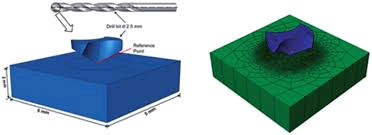


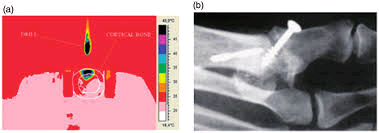
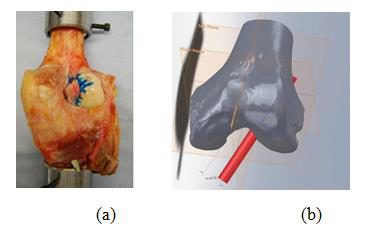
Also, as Smut Clyde noted:
“Second author Daniel Schlatterer appears as a Director of “JBR University”. The 5th author, “Prof. (Dr.) Balwant Rai” – “Program Director and Associate Professor of Aeronautic Dentistry at Kepler Space Institute” – is President of that nebulous organisation. https://web.archive.org/web/20190505000519/https://www.jbruniversity.com/about-us/“
The DGOU society remained silent, simply because they don’t care. Madry did reply, but refused to address the specific PubPeer allegations while constantly protesting about his and his wife’s publications being suspected of a papermill origin. When challenged, he never denied to have contributed his name to these papers knowingly and willingly.
The Ombudsoffice of the University of Saarland announced to investigate the affair. But then it turned out they have been forwarding Magazinov’s and mine emails to the Madry family all along. With our names.
Verena Krenberger, an official of the Ombudsoffice and assistant to the Vice-president for Research replied to my email to her office to inform Magazinov and me that we must adhere to strict confidentiality and not contact anyone as not to affect the university’s investigation.
She added Madry and Cucchiarini in cc.
Basically, the University of Saarland got the concept of whistleblower protection totally backwards and they don’t seem ashamed of it. And as for their investigation: they are probably going to charge Magazinov and yours truly with research misconduct now.
Cold Fusion now!
US scientists are invited to apply for governmental money, here the announcement by the US Department of Energy:
“DE-FOA-0002784: Exploratory Topics
This announcement is purposely broad in scope, and will cover a wide range of topics to encourage the submission of the most innovative and unconventional ideas in energy technology. The objective of this solicitation is to support high-risk R&D leading to the development of potentially disruptive new technologies across the full spectrum of energy applications. Topics under this FOA will explore new areas of technology development that, if successful, could establish new program areas for ARPA-E, or complement the current portfolio of ARPA-E programs.
Targeted Topics:
A. Low-Energy Nuclear Reactions “
Low-Energy Nuclear Reactions, or LNER, is another name for Cold Fusion, a term not used officially anymore because people will point fingers and laugh. There was just too much fraud and bullshit in cold fusion, and too many billions burned for empty promises of trash scientists. Starting with the US Americans Fleischmann and Pons:
Cold Fusion by EU Commission: a Fleischmann-Pons revival
Cold Fusion is back, and EU Commission now funds it with €10 million. One project specifically builds on Fleischmann and Pons, the other is run by Italy’s most notorious Cold Fusion loon, Francesco Celani.
Fusion is a dish best served cold
“…there are no longer any batches of the palladium used by Fleischmann and Pons (because the supplier now uses a different manufacturing process)…” -FuF wisdom
Which doesn’t at all mean that new public money should not be flushed down the same cold fusion toilet, so the European Union recently started its own cold fusion funding project, and US government now follows suit. Because the EU issued €10 million for Cold Fusion, US government now announced to award “Approximately $10 million, subject to the availability of appropriated funds” to one or more recipients.
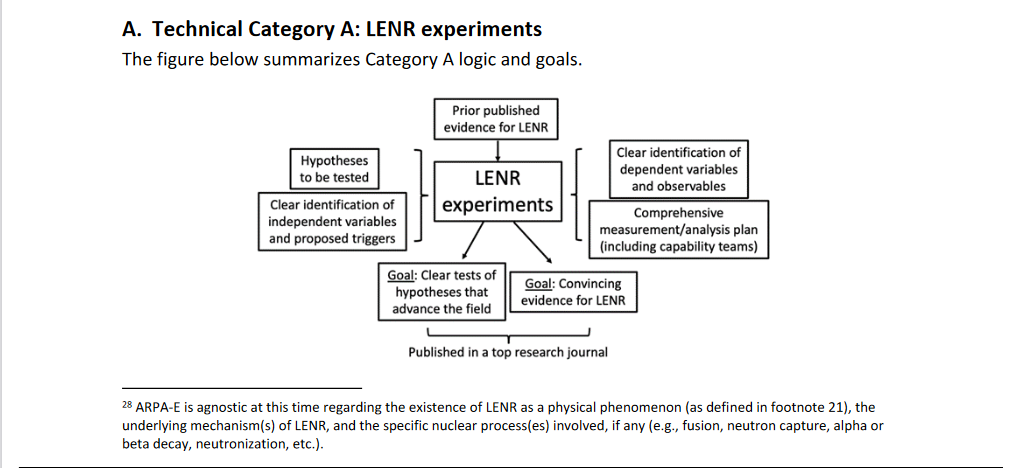
In the announcement from 12 September 2022, the ministry insists on page 61 that Cold Fusion may in fact be very real:
“ARPA-E is agnostic at this time regarding the existence of LENR as a physical phenomenon (as defined in footnote 21), the underlying mechanism(s) of LENR, and the specific nuclear process(es) involved, if any (e.g., fusion, neutron capture, alpha or beta decay, neutronization, etc.).“
In the accompanying announcement DE-FOA-0002785: Exploratory Topics SBIR/STTR, small businesses are invited to apply. I think the best candidate would be the greatest new energies entrepreneur of all times, Professor Ruggiero Santilli, resident of Miami.
Another Jewish conspiracy against Ruggiero Santilli!
EU Commission gives €6 million to an obscure German start-up, promising to convert sewage to synthetic fuels. Internet sources suggest behind all this is “Professor” Ruggiero Santilli, the litigious “Florida Genius”, eternally self-appointed Nobel Prize candidate and sock- puppeteering businessman. Exactly the kind of “fringe scientist” Smut Clyde likes to write about!
Industry Giants
Greenhouse Gas Guru
Meet University of California at San Diego Professor of Animal Science Frank Mitloehner, who calls himself “Greenhouse Gas Guru” (@GHGGuru) on Twitter. His dogma is to tell you that meat industry is actually good for the climate and to viciously attack everyone who says otherwise.
It is not because Dr Mitloehner just privately enjoys eating tortured animals so much. He is an industry shill, as Unearthed by Greenpeace uncovered:
“In early 2019, as part of a collaboration between Norway-based nonprofit EAT and British medical journal The Lancet, a team of world-leading scientists released a report that sought to answer a critical question: “Can we feed a future population of 10 billion people a healthy diet within planetary boundaries?”
Their answer: yes, but not without “transforming” our current eating habits. […]
It was a prescription for more greens and more beans, with less sugar and much less meat. […]
An analysis of the phenomenon, published later in The Lancet, described how a “digital countermovement” managed to “organise rapidly” around the hashtag #yes2meat in the days leading up to the report’s launch. […] The Lancet concluded that these online controversies showed how a “rapidly changing media landscape poses serious challenges to science communication on health and climate issues”.
The authors of this analysis presented the emergence of the #yes2meat opposition as organic and spontaneous. However, Unearthed has learned that working alongside and within that movement was a coordinated effort to mobilise scientists and academics against the report.”
This is where Mitloehner comes in:
“The Clarity and Leadership for Environmental Awareness and Research (CLEAR) Center at the University of California Davis, was set up in 2019 under the leadership of Frank Mitloehner, a prominent agriculture academic who is frequently quoted in the media discussing greenhouse gas emissions from livestock. […]
But now, a major new Unearthed investigation has revealed that the centre’s links to the meat and dairy industries are much deeper and more ingrained than previously known. More than 100 pages of correspondence between the CLEAR Center and its agribusiness supporters – obtained by Unearthed under Freedom of Information laws – reveal how the centre’s structure was agreed through a memorandum of understanding between UC Davis and an offshoot of the American Feed Industry Association (AFIA) – a trade body whose members include some of the world’s biggest livestock and feed producers. The documents show how, under the terms set out in this agreement, industry groups have committed millions of dollars of funding for CLEAR’s work, and the centre has committed to maintaining an “advisory board” of 12 of its agribusiness funders, to provide “input and advice” on the “research and communications priorities of the industry”.
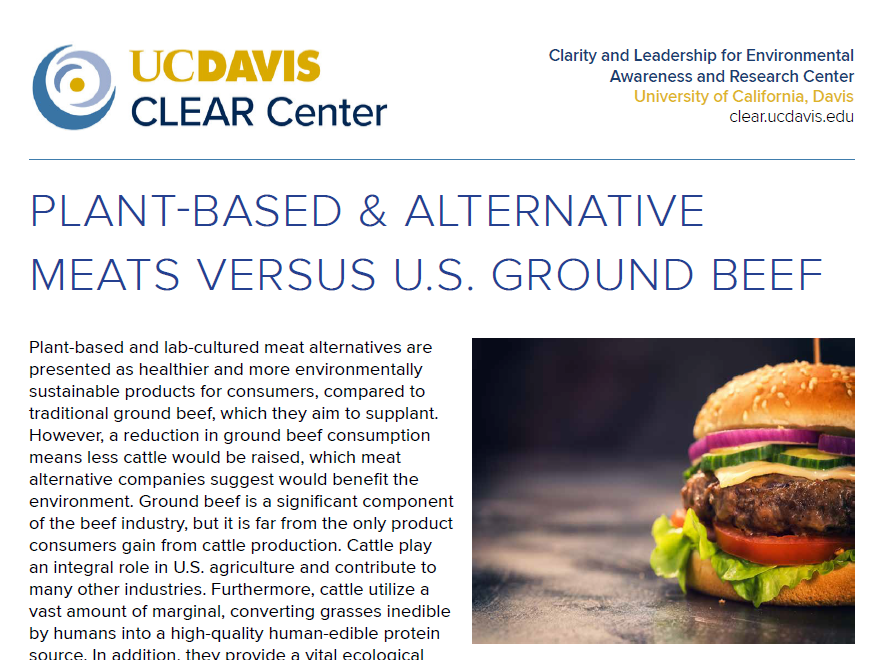
The Unearthed article goes in detail, but here are some numbers:
“The centre has also received hundreds of thousands of dollars in direct donations from agribusiness companies and other industry groups, including nearly $200,000 from the California Cattle Council. In total, these bring the donations so far received by or committed to CLEAR amount to $3.2 million – almost all of it from agribusiness interests.”

Mitloehner did an amazing job f***ing up the planet while getting rich himself:
“Mitloehner joined UC Davis in 2002. He rose to wider prominence in 2010, when he successfully argued against claims made by the UN Food and Agriculture Organisation (FAO) in its Livestock’s Long Shadow report, earning a retraction.
His beef with the report concerned its claim that livestock was responsible for more greenhouse emissions than the transport sector, which was underpinned by a flawed methodology. “
UC Davis is firmly on Mitloehner’s side, they refused communication with Unearthed. The meat industry shill brings in the money after all, and this is what academic research is all about.
Cord blood experts
A UK biotech company named Cytetech Ltd, whose business model is umbilical cord blood quackery banking wanking, published a paper in a predatory journal by the predatory publisher Herald from Hyderabad.
Jeff Drew, Rachel Slaughter, Alexander Klimentov, Wayne M Channon, Claudia Rees, William Harrington, Megan Watts and Lesley-Ann Martin TotiCyte, a Paradigm Shift in Stem Cell Isolation and Storage from Umbilical Cord Blood Journal of Stem Cells Research, Development & Therapy (2021) doi: 10.24966/srdt-2060/100073
The first and last authors, Jeff Drew and Lesley-Ann Martin, are husband and wife. Wayne Channon is an entrepreneur with a degree in mathematical physics from 1980. Claudia Rees is quite possibly his daughter, who recently graduated with a degree in politics and eastern European studies.
Here a comment on PubPeer:
“The methods section of this paper says that 76 fresh umbilical cord blood units were purchased from Cells4Life and were processed using a range of methods. Cells4Life is a UK commercial cord blood bank that charges parents to store their child’s cord blood. There is no information in the paper about informed consent or if ethics approval from a Research Ethics Committee was obtained for this study.
All authors are from the company Cytetech. According to the Human Tissue Authority’s (HTA) latest inspection report of this establishment, Cytetech is only licensed to store umbilical cord blood. It is not licensed to process it: https://content.hta.gov.uk/sites/default/files/2022-08/2022-07-05 22671 CyteTech Inspection report.pdf
Cytetech therefore appears to have carried out a licensable activity without holding an appropriate licence from the HTA, which is an offence under the Human Tissue Act 2004.
The main claim of the paper is that Cytetech’s product “Toticyte” is superior to other methods of processing cord blood. The conclusion states “We found that TotiCyte dramatically improved the viable recovery of haemopoietic stem cells compared to standard industry methods.”
In the study, haematopoietic stem cells (HSCs) were identified by expression of CD34. Fig 1D shows that using Toticyte, about 65% of HSCs survive freezing, compared to only 40% using SEPAX 2.
However, the paper fails to cite a 2019 study performed by researchers from a public cord bank who show that using SEPAX 2, about 70% of HSCs survive freezing (see Fig. 2A of this paper: https://www.sciencedirect.com/science/article/pii/S1083879119305725)
The Cells4Life website states: “based on CyteTech’s peer reviewed publication showing that TotiCyte delivers 2.2 to 3 times more haematopoietic stem cells at the point of use than other cord blood processing systems in use in the UK.” See https://cells4life.com/stem-cell-collection-whats-involved/ (scroll to bottom of page).
Clicking on “peer reviewed publication” on the above website brings the reader to the Cytetech paper. Apart from the fact that the Cytetech paper seems to overlook the superior results with SEPAX 2 in the 2019 publication, questions are raised over whether the Cytetech paper was actually peer-reviewed. The paper was submitted on May 14th 2021 and accepted on May 25th 2021.”
On their website, Cytetech lure expecting parents with promises that in future the umbilical cord stem cell therapy will be able to cure all diseases.

A certain Hoya camphorifolia commented:
“Herald Scholarly Open Access is just another band of OMICS wannabees from Hyderabad, only useful for publishing press releases.”
Retraction Watchdogging
Dove slaughter
Dove Press (Part of Taylor & Francis) continues retracting fake papers by the serial fraudsters who bought their authorships off a papermill.
Zikra Zulfiqar , Fawad Ali Shah , Shagufta Shafique , Abdullah Alattar , Tahir Ali , Arooj Mohsin Alvi , Sajid Rashid , Shupeng Li Repurposing FDA Approved Drugs as JNK3 Inhibitor for Prevention of Neuroinflammation Induced by MCAO in Rats Journal of Inflammation Research (2020) doi: 10.2147/jir.s284471
Retraction note from 2 November 2022:
“The Editor and Publisher of Journal of Inflammation Research wish to retract the published article. Concerns were raised regarding the duplication of several images from Figures 9–11. Specifically,
- Figure 9E, HO-1, Striatum, Vehicle + Sham appears to have been duplicated with the same image for Figure 10B, p-JNK, Striatum, Vehicle + Sham.
- Figure 9E, HO-1, Striatum, Estazolam + MCAO appears to have been duplicated with the same image for Figure 11A, p-NFκB, Striatum, Vehicle + MCAO.
- Figure 9E, HO-1, Striatum, Vehicle + Sham appears to have been duplicated with the same image for Figure 11A, p-NFκB, Striatum, Vehicle + Sham.
- Figure 9E, HO-1, Striatum, Vehicle + Sham appears to have been duplicated with the same image for Figure 11B, TNF-α, Striatum, Vehicle + Sham.
- Figure 10B, p-JNK, Cortex, Vehicle + Sham appears to have been duplicated with the same image for Figure 11B, TNF-α, Cortex, Vehicle + Sham.
- Figure 10B, p-JNK, Cortex, Vehicle + MCAO appears to have been duplicated with the same image for Figure 11B, TNF-α, Cortex, Vehicle + MCAO.
- Figure 10B, p-JNK, Striatum, Leucovorin + MCAO appears to have been duplicated with the same image for Figure 11B, TNF-α, Striatum, Vehicle + MCAO.
- Figure 11A, p-NFκB, Striatum, Vehicle + Sham appears to have been duplicated with the same image for Figure 11B, TNF-α, Striatum, Vehicle + Sham.
- Figure 11A, p-NFκB, Cortex, Estazolam + MCAO appears to have been duplicated with the same image for Figure 11B, TNF-α, Cortex, Estazolam + MCAO.
The authors responded to our queries but were unable to provide a satisfactory explanation for the duplicated images.”
Komal Naeem , Lina Tariq Al Kury , Faiza Nasar , Abdullah Alattar , Reem Alshaman , Fawad Ali Shah , Arif-ullah Khan , Shupeng Li Natural Dietary Supplement, Carvacrol, Alleviates LPS-Induced Oxidative Stress, Neurodegeneration, and Depressive-Like Behaviors via the Nrf2/HO-1 Pathway Journal of Inflammation Research (2021) doi: 10.2147/jir.s294413

Retraction note from 2 November 2022:
“At the authors request, the Editor and Publisher of Journal of Inflammation Research wish to retract the published article. The authors became aware of suspected duplicated images in Figures 4 and 5 and requested for the article to be retracted. Specifically,
- Figure 4B, Bcl-2, Hippocampus, FLX+LPS appears to have been duplicated with the same image for Figure 4C, Caspase-3, Hippocampus, CAR 20+LPS.
- Figure 5D, TNF-α, Cortex, LPS appears to have been duplicated with the same image for Figure 5D, TNF-α, Cortex, CAR 20+ATRA+LPS.
- Figure 5D, TNF-α, Cortex, ATRA+LPS appears to have been duplicated with the same image for Figure 5E, p-NFκB, Cortex, ATRA+LPS (which has been flipped).
Shagufta Naz , Lina Tariq Al Kury , Humaira Nadeem , Fawad Ali Shah , Aman Ullah , Rehan Zafar Paracha , Muhammad Imran , Shupeng Li Synthesis, In Silico and Pharmacological Evaluation of New Thiazolidine-4-Carboxylic Acid Derivatives Against Ethanol-Induced Neurodegeneration and Memory Impairment Journal of Inflammation Research (2022) doi: 10.2147/jir.s357082


Retraction note from 2 November 2022:
“The Editor and Publisher of the Journal of Inflammation Research wish to retract the published article. Concerns were raised regarding the alleged duplication of images in Figure 4 and Figure 6 with similar images from Ullah et al, 2022 (https://doi.org/10.2147/JIR.S351913). Specifically,
- Figure 4E, Hippocampus, P9, appears to have been duplicated with the same image from Figure 8E, Hippocampus, Ethanol + DNP from Ullah et al, 2022 (https://doi.org/10.2147/JIR.S351913).
- Figure 4E, Hippocampus, Saline appears to have been duplicated with the same image from Figure 4E, Hippocampus, Ethanol.
- Figure 6B, TNF-α, Hippocampus, P8, appears to have been duplicated with the same image from Figure 10D, TNF-α, Hippocampus, Ethanol + Cb from Ullah et al, 2022 (https://doi.org/10.2147/JIR.S351913).
- Figure 6C, p-NF-κB, Hippocampus, P8, appears to have been duplicated with the same image from Figure 10F, COX-2, Hippocampus, Ethanol + DNP from Ullah et al, 2022 (https://doi.org/10.2147/JIR.S351913).
- Figure 6C, p-NF-κB, Hippocampus, P8, appears to have been duplicated with the same image from Figure 6C, p-NF-κB, Hippocampus, P9.
The authors responded to our queries but were unable to provide a satisfactory explanation for the duplicated images.”
Aman Ullah , Lina Tariq Al Kury , Yusuf S Althobaiti , Tahir Ali , Fawad ALi Shah Benzimidazole Derivatives as New Potential NLRP3 Inflammasome Inhibitors That Provide Neuroprotection in a Rodent Model of Neurodegeneration and Memory Impairment Journal of Inflammation Research (2022) doi: 10.2147/jir.s351913


Retraction note from 2 November 2022:
“The Editor and Publisher of the Journal of Inflammation Research wish to retract the published article. Concerns were raised regarding the alleged duplication of images in Figures 8 and 10 with similar images from Naz et al, 2022 (https://doi.org/10.2147/JIR.S357082). Specifically,
- Figure 8E, Hippocampus, Ethanol + DNP, appears to have been duplicated with the same image from Figure 4E, Hippocampus, P9 from Naz et al, 2022 (https://doi.org/10.2147/JIR.S357082).
- Figure 10B, p-NF-κB, Hippocampus, Saline, appears to have been duplicated with the same image from Figure 10B, p-NF-κB, Hippocampus, Ethanol + DNP.
- Figure 10D, TNF-α, Hippocampus, Ethanol, appears to have been duplicated with the same image from Figure 10F, COX-2, Hippocampus, Ethanol.
- Figure 10D, TNF-α, Hippocampus, Ethanol + Cb, appears to have been duplicated with the same image from Figure 6B, TNF-α, Hippocampus, P8 from Naz et al, 2022 (https://doi.org/10.2147/JIR.S357082).
- Figure 10F, COX-2, Hippocampus, Ethanol + DNP, appears to have been duplicated with the same image from Figure 6C, p-NF-κB, Hippocampus, P8 from Naz et al, 2022 (https://doi.org/10.2147/JIR.S357082).
The authors responded to our queries but were unable to provide a satisfactory explanation for the duplicated images.”
Elsevier’s time warp
Alexander Magazinov brings sad news for the highly cited researcher Yu-Ming Chu, a man who not only buys his publications from papermills, but also pays them to reference his already published papers. This paper was cited 365 times:
Yu-Ming Chu , B.M. Shankaralingappa , B.J. Gireesha , Faris Alzahrani , M. Ijaz Khan , Sami Ullah KhanCombined impact of Cattaneo-Christov double diffusion and radiative heat flux on bio-convective flow of Maxwell liquid configured by a stretched nano-material surface Applied Mathematics and Computation (2022) doi: 10.1016/j.amc.2021.126883
The paper was published on 29 December 2021. Elsevier’s retraction notice, officially published on 15 April 2022, declared:
“This article has been retracted at the request of the Editor-in-Chief.
Post-publication, the editors discovered suspicious changes in authorship between the original submission and the revised version of this paper.
In summary: the names of four authors were removed during revision. The names of the authors B. M. Shankaralingappa, B. J. Gireesha and Faris Alzahrani were all then added to the revised paper without explanation and without the exceptional approval by the handling Editor, which is contrary to the journal policy on changes to authorship. The editor investigated further and the explanation provided by the corresponding author was deemed unsatisfactory. The editors therefore feel that the findings of the manuscript cannot be relied upon.
The authors do not agree to this retraction.”
Basically, it was a papermill product where additional authorships were sold after the paper was in peer review. Just like this Chu paper, cited 350 times:
Mubbashar Nazeer , Farooq Hussain , M. Ijaz Khan , Asad-ur-Rehman , Essam Roshdy El-Zahar , Yu-Ming Chu , M.Y. Malik RETRACTED: Theoretical study of MHD electro-osmotically flow of third-grade fluid in micro channel Applied Mathematics and Computation (2022)
doi: 10.1016/j.amc.2021.126868
That paper was published on 31 December 2021, and the retraction notice is dated 1 May 2022:
“This article has been retracted at the request of the Editor-in-Chief.
Post publication, the editors discovered suspicious changes in authorship between the original submission and the revised version of this paper.
In summary: the name of one author was removed during revision. The names of the authors Farooq Hussain, M. Ijaz Khan, Essam Roshdy El-Zahar, Yu-Ming Chu and M. Y. Malik were all then added to the revised paper without explanation and without the exceptional approval by the handling Editor, which is contrary to the journal policy on changes to authorship. The editor investigated further and the explanation provided by the original corresponding author was deemed unsatisfactory. The editors therefore feel that the findings of the manuscript cannot be relied upon.
The authors do not agree to this retraction.”
Thank you Elsevier for the swift investigation and action! Oh wait.
Magazinov notes:
“The PDF metadata indicates 2022-11-02, but that may or may not be accurate.
Also see the Crossref entry, archived as of 2022-11-05. Link.”
Also for the first Chu paper, its CrossRef entry says it was indexed on 8 November 2022, and then updated to 1 May 2022.
Basically, Elsevier wants you to believe they acted very fast on Chu’s fraud, that the whole investigative work was done by a watchful honest editor, totally without Magazinov’s emails which came much later. Hence the time travel.
Retraction announced
A Springer Nature executive announced in an email an upcoming retraction (“Dear reader, I would like to inform you that we are going to retract the article.“). It was flagged on PubPeer by Aneurus Inconstans, the first author, I must note, works at “Camel Biomedical Research Unit, College of Pharmacy and Medicine, King Saud University, Riyadh, Kingdom of Saudi Arabia”. There are no camels mentioned in this paper about the cancer-curing magic of sandalwood. It may have been sourced from a papermill:
Sarita Saraswati , Shakti Kumar , Abdulqader A Alhaider α-santalol inhibits the angiogenesis and growth of human prostate tumor growth by targeting vascular endothelial growth factor receptor 2-mediated AKT/mTOR/P70S6K signaling pathway Molecular Cancer (2013) doi: 10.1186/1476-4598-12-147






Garbage pseudoscience like this aimed to scam with “traditional medicine”, plus likely citations scams, is how this obscure BioMedCentral cancer research journal achieved its bizarre impact factor of 41.4 (!). No, dear reader, the responsible Editor-in-Chief of Molecular Cancer is not some crook from Asia, but a white French man in USA: Christophe Nicot, institute director at the Kansas University Medical Center, also many of the associate editors are white European academics.
Update 22.08.2023: the paper was retracted on 15 December 2022:
“The Editor in Chief has retracted this article because of significant concerns regarding a number of Figures presented in this work, which question the integrity of the data.”
On 22 August 2023, Christoph Nicot placed a comment under this article, and sent me this email:
“I posted a response to your article, and I hope you will read it. I would like an apology for the insinuations regarding an article published in Mol. Cancer in 2013 for which you associate me as editor in chief of the journal. In fact, I was not and my role with the journal started on January 1st, 2014. I do have a contract to prove it. The editor at the time was Dr. Alan Storey. In addition, the article you mention was retracted by me a month after your publication. I would greatly appreciate you send me an email to explain and to please correct the article because as it stands it may be considered defamatory and wrongly associate with my name. Thank you for your time.
Dr. Christophe Nicot“
I find it sad academics are only able to communicate via legal threats and demands for apology.
But it is indeed interesting that Alan Storey was the responsible editor at that time. This former UK professor already has 2 retractions of his own (read here), has left academia in 2013, and works since as medical writer for changing businesses. Storey’s many forgeries are recorded on PubPeer, some were briefly mentioned here:
Editors vs the Anonymous
A tale of brave academic editors fighting those bad, naughty, annoying anonymous whistleblower trolls
Sleuth to retract own papers
Another retraction is probably in the making, for this paper about Alzheimer’s:
Othman Ghribi , Mikhail Y. Golovko , Brian Larsen , Matthew Schrag , Eric J. Murphy Deposition of iron and beta-amyloid plaques is associated with cortical cellular damage in rabbits fed with long-term cholesterol-enriched diets Journal of Neurochemistry (2006) doi: 10.1111/j.1471-4159.2006.04079.x


The co-author of the paper is Matthew Schrag, now researcher at Vanderbilt University and recently known as the image integrity sleuth who exposed the Cassava Sciences fraud with their phony Alzheimer’s drug.
Sylvain Lesné is a failed scientist
From Lesné’s public shame to successful role models of neuroscience like Aguzzi and Tessier-Lavigne.
Cassava fraud and Alzheimer’s capitalism
“even Theranos didn’t submit fake data to FDA”
Schrag replied on PubPeer in August 2022.
“I appreciate the close reading of our paper. I will defer further comments to Dr. Ghribi as I was an undergraduate on this project, except to say that I believe this issue was corrected in the erratum 15 years ago.”
The Erratum from 2007 stated:
“In [1], figures 1 and 4 were originally printed in error. The following figures and legends below are the corrected versions””
But Figure 5 was not corrected. And Elisabeth Bik thought the corrected duplications couldn’t have been mere mistakes:

Cyan circles: Two of the regions representing Ab 42 plaques appear to look identical. These similarities suggest that the originally published panel (e) might have been a digitally altered version of panel (c).“
The corrected figure 1 in the Erratum contains the fake panel (e) with its cloned dark spots. And then Bik found more, specifically some utterly fake gels:


Schrag joined the debate by posting his own analysis confirming further data forgery in his own paper:
“I agree with all of the concerns raised above. To complete the public record regarding this unfortunate publication, I am providing the following additional concerns. The coauthors on this work have initiated appropriate corrective action.”

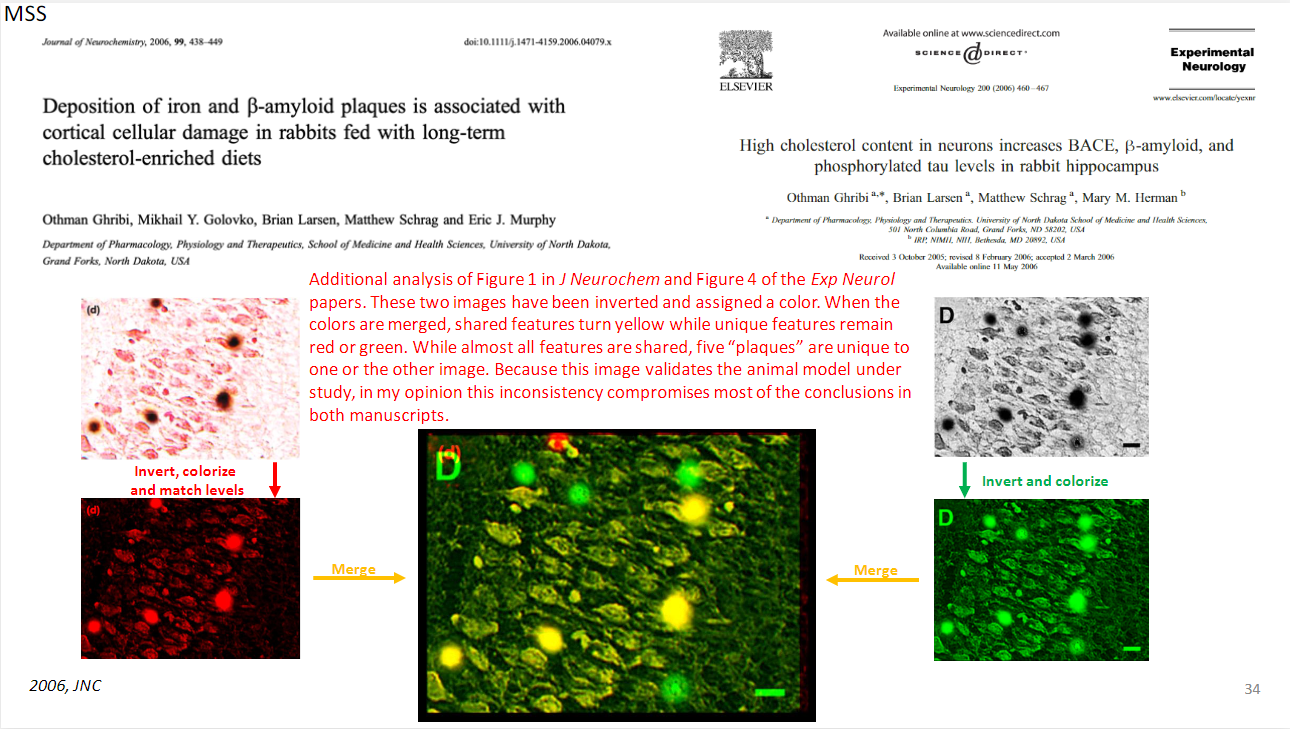
It is reasonable to assume the authors will have to ask for retraction. By the way, the last author and “Handling Editor” of this journal, the University of North Dakota professor Eric Murphy, has just won the North Dakota House of Representatives elections for the Republican Party:
There is another paper, also with Schrag, and with same first author, Othman Ghribi, now professor at the University of North Dakota School of Medicine.
Othman Ghribi , Brian Larsen , Matthew Schrag , Mary M. Herman High cholesterol content in neurons increases BACE, beta-amyloid, and phosphorylated tau levels in rabbit hippocampus Experimental Neurology (2006) doi: 10.1016/j.expneurol.2006.03.019


Schrag confirmed the duplications and wrote on PubPeer:
“As previously noted, I was an undergraduate student in this lab and did not produce the figures. The PI’s lab has been closed for several years and the senior author is deceased. I have made inquiries to the PI and contacts in the originating department about the availability of the original data, and it was thoroughly removed when the lab was closed.
I must confess that I do not have confidence in the data in this manuscript. I am addressing these concerns with the editors of the journal.”
To me, Schrag provided this statement:
“This is a sad and frustrating story. The problems with the 2006 Journal of Neurochemistry and Experimental Neurology papers are substantial and both papers, in my view, should clearly be retracted as soon as possible.”
Science Breakthroughs
We remain on the topic of Alzheimer’s.
Green tea
A press release by UC Los Angeles announced a cure:
“University of California, Los Angeles (UCLA) researchers used a molecule present in green tea to uncover more molecules that may break up protein tangles in the brain, which are known to cause Alzheimer’s disease and other disorders.
Tau fibers, which are lengthy, multilayered filaments that create tangles and attack neurons, are known to be broken up by the green tea molecule EGCG.”
Obviously, green tea. If it cures cancer as so many papers say, why not Alzheimer’s? One should not argue with a fancy-named journal:
Paul M. Seidler, Kevin A. Murray, David R. Boyer, Peng Ge, Michael R. Sawaya, Carolyn J. Hu, Xinyi Cheng, Romany Abskharon, Hope Pan, Michael A. DeTure, Christopher K. Williams, Dennis W. Dickson, Harry V. Vinters and David S. Eisenberg, Structure-based discovery of small molecules that disaggregate Alzheimer’s disease tissue derived tau fibrils in vitro , Nature Communications (2022) DOI: 10.1038/s41467-022-32951-4
It was basically a Big Pharma conspiracy:
““If we could break up these fibers we may be able to stop the death of neurons,” said David Eisenberg, UCLA professor of chemistry and biochemistry whose lab led the new research. “Industry has generally failed at doing this because they mainly used large antibodies that have difficulty getting into the brain. For a couple of decades, scientists have known there’s a molecule in green tea called EGCG that can break up amyloid fibers, and that’s where our work departs from the rest.”
EGCG has been studied extensively but has never worked as a drug for Alzheimer’s because its ability to dismantle tau fibers works best in water, and it doesn’t enter cells or the brain easily. Also, as soon as EGCG enters the bloodstream it binds to many proteins besides tau fibers, weakening its efficacy.”
But the UCLA geniuses solved the problem:
“Kevin Murray […] ran computer simulations on a library of 60,000 brain and nervous system-friendly small molecules with the potential to bind to the same sites. He found several hundred molecules that were 25 atoms or less in size, all with the potential to bind even better to the tau fiber pharmacophores. Experiments with the top candidate molecules identified from the computational screening identified about a half dozen that broke up the tau fibers.
“Using the super-computing resources available at UCLA, we are able to screen vast libraries of drugs virtually before any wet-lab experiments are required,” Murray said.
A few of these top compounds, most notably molecules called CNS-11 and CNS-17, also stopped the fibers from spreading from cell to cell. The authors think these molecules are candidates for drugs that could be developed to treat Alzheimer’s disease.”
The drug is not in the pharmacies just yet, so you are probably supposed to drink green tea till then. The press release doesn’t mention what the paper does, that Eisenberg is “SAB chair and equity holder” of ADRx, Inc, a $24 million-heavy company which he founded and which advertises to be “Transforming atomic structures into small molecule therapies to treat Alzheimer’s, ALS, Parkinson’s Disease, and more“.
The real cause of Alzheimer’s
An press release by the Griffith University in Australia informs of a breakthrough:
“New research suggests nose picking could increase risk for Alzheimer’s and dementia
Griffith University researchers have demonstrated that a bacteria can travel through the olfactory nerve in the nose and into the brain in mice, where it creates markers that are a tell-tale sign of Alzheimer’s disease.
The study, published in the journal Scientific Reports, showed that Chlamydia pneumoniae used the nerve extending between the nasal cavity and the brain as an invasion path to invade the central nervous system. The cells in the brain then responded by depositing amyloid beta protein which is a hallmark of Alzheimer’s disease.
Professor James St John, Head of the Clem Jones Centre for Neurobiology and Stem Cell Research, is a co-author of the world first research.
“We’re the first to show that Chlamydia pneumoniae can go directly up the nose and into the brain where it can set off pathologies that look like Alzheimer’s disease,” Professor St John said. “We saw this happen in a mouse model, and the evidence is potentially scary for humans as well.”
This is the paper:
Anu Chacko, Ali Delbaz, Heidi Walkden, Souptik Basu, Charles W. Armitage, Tanja Eindorf, Logan K. Trim, Edith Miller, Nicholas P. West, James A. St John, Kenneth W. Beagley, Jenny A. K. Ekberg Chlamydia pneumoniae can infect the central nervous system via the olfactory and trigeminal nerves and contributes to Alzheimer’s disease risk. Sci Rep (2022). doi: 10.1038/s41598-022-06749-9
Human clinical trials are already announced by Prof St John:
““We need to do this study in humans and confirm whether the same pathway operates in the same way. It’s research that has been proposed by many people, but not yet completed. What we do know is that these same bacteria are present in humans, but we haven’t worked out how they get there.”
There are some simple steps to look after the lining of your nose that Professor St John suggests people can take now if they want to lower their risk of potentially developing late-onset Alzheimer’s disease.
“Picking your nose and plucking the hairs from your nose are not a good idea”,” he said.
“We don’t want to damage the inside of our nose and picking and plucking can do that.”
I wasn’t going to pick my nose. I was going to thump him.
Smut’s secret
Scientists discover why Smut Clyde is protected from Alzheimer’s: it’s beer!
A press release by the American Chemical Society (ACS) informs:
“Beer is one of the oldest and most popular beverages in the world, with some people loving and others hating the distinct, bitter taste of the hops used to flavor its many varieties. But an especially “hoppy” brew might have unique health benefits. Recent research published in ACS Chemical Neuroscience reports that chemicals extracted from hop flowers can, in lab dishes, inhibit the clumping of amyloid beta proteins, which is associated with Alzheimer’s disease (AD). “
Scientists from University Milano-Bicocca in Italy made a genius (after-work) discovery (in a pub):
“To identify these compounds, the researchers created and characterized extracts of four common varieties of hops using a method similar to that used in the brewing process. In tests, they found that the extracts had antioxidant properties and could prevent amyloid beta proteins from clumping in human nerve cells.
The most successful extract was from the Tettnang hop, found in many types of lagers and lighter ales. When that extract was separated into fractions, the one containing a high level of polyphenols showed the most potent antibiotic and aggregation-inhibiting activity. It also promoted processes that allow the body to clear out misfolded, neurotoxic proteins.
Finally, the team tested the Tettnang extract in a C. elegans model and found that it protected the worms from AD-related paralysis, though the effect was not very pronounced. The researchers say that although this work may not justify drinking more bitter brews, it shows that hop compounds could serve as the basis for nutraceuticals that combat the development of AD.”
Here is the paper:
Alessandro Palmioli , Valeria Mazzoni , Ada De Luigi , Chiara Bruzzone , Gessica Sala , Laura Colombo , Chiara Bazzini , Chiara Paola Zoia , Mariagiovanna Inserra , Mario Salmona , Ivano De Noni , Carlo Ferrarese , Luisa Diomede , Cristina Airoldi Alzheimer’s Disease Prevention through Natural Compounds: Cell-Free, In Vitro, and In Vivo Dissection of Hop (Humulus lupulus L.) Multitarget Activity ACS Chemical Neuroscience (2022) doi: 10.1021/acschemneuro.2c00444
“The authors thank Enrico Dosoli and “Birrificio Menaresta” […] for providing hop samples.”
Cheers to science!
News in Tweets
- Maybe this papermill and Dror Koldkin-Gal should join forces? “Dear Dr(s), We are working with the manuscript writing and publication company i.e. “Writing Solution Pvt. Ltd since 2015”. If you have manuscript writing or publication order then you can take our service. We will write high quality, plagiarism-free manuscript and we will submit in EMBASE/PubMed/Scopus/SCIE indexed Print Journal and provide you with guaranteed Publication in 1-2 weeks (fast mode).“
- Mass retractions at IOS Press for polymer papermillers: “The Publisher and Editor-in-Chief of the journal Main Group Chemistry retract a total of 33 articles from the journal’s online catalog. The articles were published in different issues of the journal during the period 2018– 2020. All articles affected by this retraction notice have sound evidence of systematic manipulation of the publication process and similar problems were found across articles.” Note to journalists: as usual, you must credit Jennifer Byrne and Retraction Watch, but never this guy:
Polymer Papermillers Taking the Piss
Papermill Industry enters its Logical Growth Phage. Smut Clyde explains what coordination polymer chemistry has to do with chickenshit.
- “We are pleased to announce that Lianwei Peng, a researcher at the Graduate School of Science (at the time) (retired at the end of May 2011), published five papers from 2008 to 2012 as authors, and has published a total of 11 papers. There was forgery and falsification by image processing in the dot figure, and it was recognized that former researcher Peng had acted fraudulently.” – Kyoto University n 24 June 2022, Google-translated
- Unexpected retraction at ACS: “The authors retract this article due to an error in the data used in Figure 6. The authors have concluded that the data in Figure 6 cannot be used to support the conclusions of the article. This decision has been approved by Alexandre Detappe, Rajiv Kumar, Thomas Ireland, Lisa Cameron, Douglas E. Biancur, Vincent Motto-Ros, Lucie Sancey, Srinivas Sridhar, G. Mike Makrigiorgos, and Ross I. Berbeco. Sijumon Kunjachan did not respond.” Possibly a misconduct investigation in Harvard, all blame going to first author Kunjachan?
- That’s very nice, but Carlo Croce still has his job at Ohio State and a huge fat salary with industry gigs connected to it.
Croce begat Calin, and Calin begat Girnita…
An academic dynasty of bad cancer research.
- Cassava fraudsters are suing their critics because the Alzheimer’s drug was exposed as fraudulent.
Facts and Fiction of Cassava Sciences
Attack is the best form of defence. Especially when your commercial clinical research is tainted by preclinical Photoshop fraud.
Cassava fraud and Alzheimer’s capitalism
“even Theranos didn’t submit fake data to FDA”
- Lab leaks are all conspiracy theories: “After the student [who accidentlaly injected herself with Chikungunya virus] told her supervisor about the accident in September 2016, Washington University reported it to the National Institutes of Health, but until now, the event has remained out of public view. So have hundreds of other incidents in U.S. labs, including four other needle injuries at Washington University. An Intercept investigation based on over 5,500 pages of NIH documents obtained under the Freedom of Information Act has uncovered a litany of mishaps: malfunctioning equipment, spilled beakers, transgenic rodents running down the hall, a sedated macaque coming back to life and biting a researcher hard enough to lacerate their hand.” (The Intercept)
The Lab Leak Theory
A lab leak theory of the COVID-19 origins has enough circumstantial evidence and historical basis to support the urgent need for an independent and unbiased investigation. But until recently, scientists dismissed lab leak as a conspiracy theory. In public at least.
I thank all my donors for supporting my journalism. You can be one of them!
Make a one-time donation:
I thank all my donors for supporting my journalism. You can be one of them!
Make a monthly donation:
Choose an amount
Or enter a custom amount
Your contribution is appreciated.
Your contribution is appreciated.
DonateDonate monthly
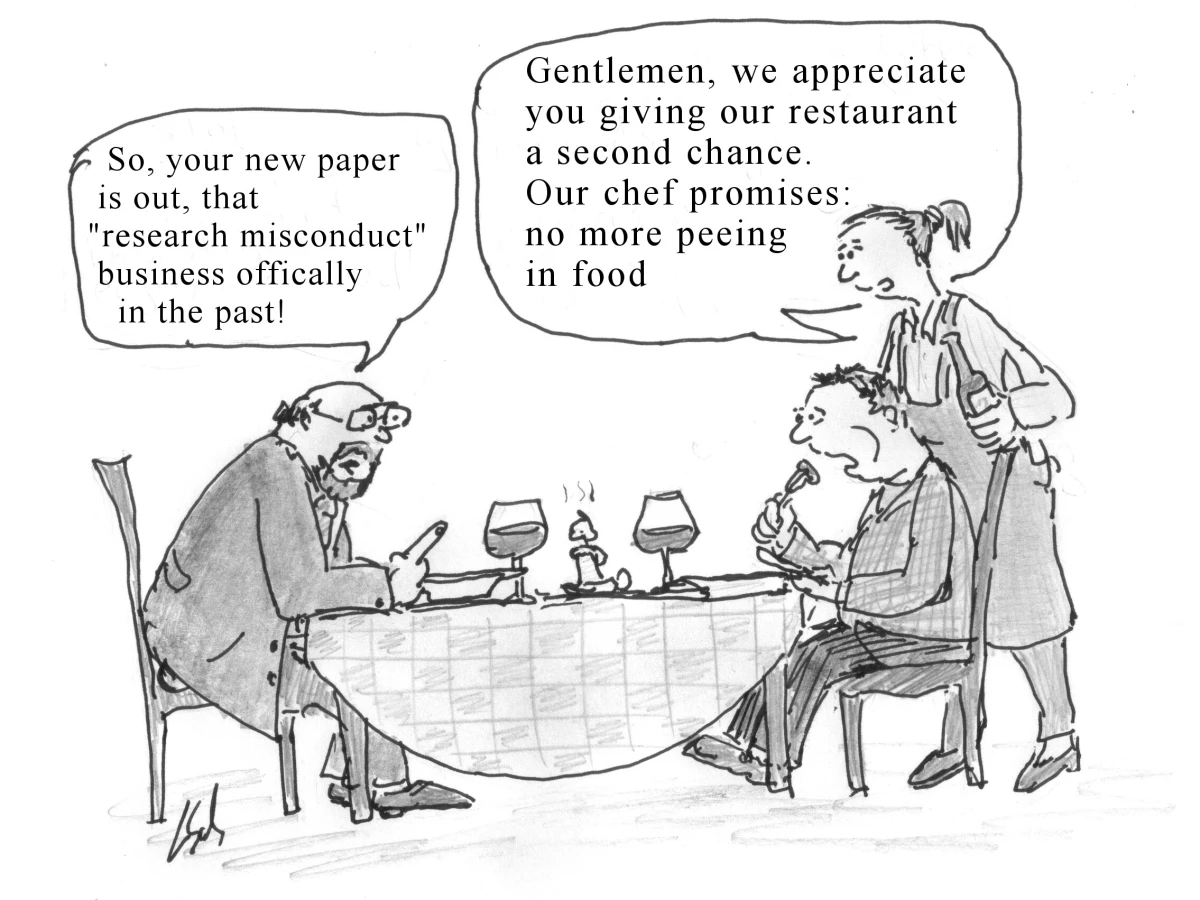





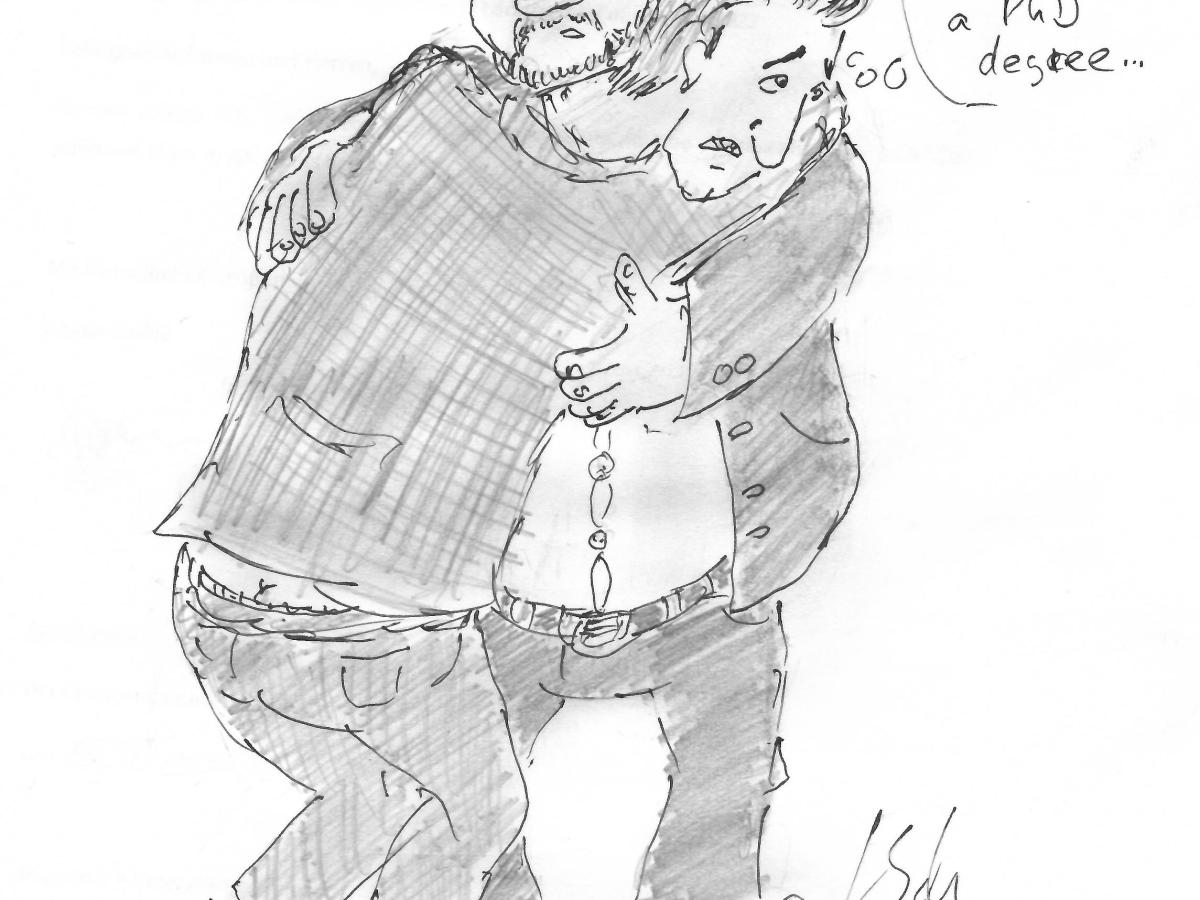


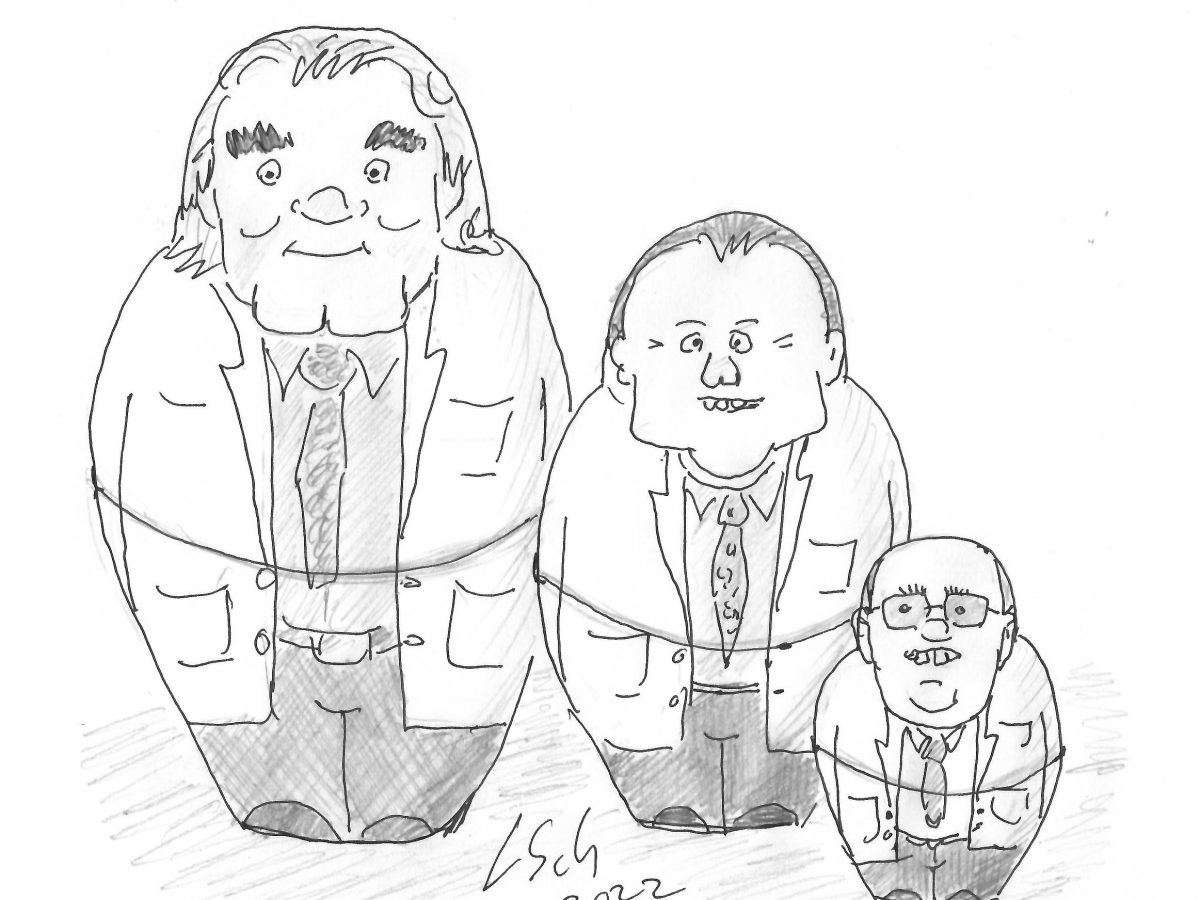



Scooped by Science!
Matthew Schrag’s story is in Science:
https://www.science.org/content/article/i-m-nauseated-alzheimer-s-whistleblower-finds-possible-misconduct-his-mentor-their
“According to Schrag, in a phone conversation the senior scientist emotionally acknowledged “problems” in many of his papers, including those two co-authored with Schrag, and accepted responsibility. During their discussion, which Schrag recounted to Science, Ghribi maintained to his former student that the underlying findings were correct but admitted to exaggerating data.
After initially agreeing to an in-person interview with Science, Ghribi backed out a few days before the appointment, citing a pending UND investigation.[…]
After reviewing additional comments posted to PubPeer about other Ghribi papers, Schrag says he recently resolved to take a deeper look at his mentor’s work, including all their joint papers. He enlisted help from microbiologist and forensic image analyst Elisabeth Bik and another image sleuth—a nonscientist who uses the pseudonym Cheshire, in part to minimize legal risks. (Science confirmed Cheshire’s identity and agreed to keep it confidential.) […]
In their assessment of Ghribi’s work from 2001 through 2019, the three found suspect images in 33 papers, including the three co-authored with Schrag. Ghribi was the only author shared by all of the papers, and he was usually in a prominent position as either first or last author. “
LikeLike
Here are the Ghribi papers on PubPeer, 17 of them now:
https://pubpeer.com/search?q=ghribi
LikeLike
Huh. Another Ombudsperson forwards my entire email exchange to the accused. It is about the case of the mysterious Vickers reference.
This book chapter:
Alireza Shahryari, Zahra Nazari , Marie Saghaeian Jazi , Fatemeh Hashemi-Shahraki , Katharina Wißmiller, Weiwei Xu , Ingo Burtscher, Heiko Lickert Gene Therapy Comprehensive Pharmacology (2022) doi: 10.1016/b978-0-12-820472-6.00213-9
“Approximately 16% of all DMD patients have exon 51 skippable mutations, making exon 51 a suitable target for DMD therapy (Vickers, 2017).”
The first author commented on PubPeer:
“This is Alireza the first author of the Gene Therapy chapter of the book of Comprehensive Pharmacology. I would like to thank you for your comment. It is greatly appreciated. That reference was in our Endnote library and has been wrongly added to our chapter. “
Yet my colleagues proved that this is impossible. The Vickers reference creeps in via a totally different route, which we won’t disclose right now. Certainly not to the Helmholtz Ombudsman who just breached all basics of confidentiality.
Rolf Holle, Ombudsman at the Helmholtz Institute Munich , replied to me, putting Lickert in cc, thus forwarding him our entire email exchange. Translated:
“I have since consulted Prof. Lickert. He confirmed to me that he, as the last author, had no recognizable indications that the review article could not have been written by the first author himself and with the active participation of the named co-authors. The Iranian co-authors are from the institute where the first author worked before his stay in Germany. Mr. Lickert was involved in the revision of the manuscript draft himself, but he can only refer to the first author’s statement regarding the use of the Citation Manager. In my opinion, it is not surprising that he did not notice the Vickers quote in a review article with a large number of citations.
If, from your point of view, the suspicion of a possible publication of a papermill article has not been dispelled (the astonishing fact remains why the Vickers quote crept in), only the first author can provide further information, possibly after later consultation with the Iranian co-authors. Mr. Lickert, who supervised his doctorate at the Helmholtz Center in Munich, has no doubts about the quality of Mr. Shahryari’s scientific work.”
LikeLike
hi Leonid, LOWI states in a recent decision that complainers first need to have permission from LOWI and/or from the board of the University, in this case the University of Utrecht, before a complainer can ask an external expert, in this case an emeritus professor, for a report / review / comments on confidential statements etc. of the complainant.
“Het had op de weg van Verzoekers of hun advocaat gelegen om alvorens vertrouwelijke stukken uit de procedure te delen met de door hen aangezochte emeritus hoogleraar, contact op te nemen met het Bestuur en/of het LOWI. Zoals het Bestuur terecht naar voren heeft gebracht gaat het hier immers om vertrouwelijke en niet-openbare stukken. Door dit niet te doen zijn Verzoekers niet zorgvuldig omgegaan met de op hen rustende geheimhoudingsplicht.”
This quote is part of item 16 at https://lowi.nl/advies-2022-13/
LikeLike
Hypothesis: boogers are composed of beta-amyloid.
As an inveterate nose picker since childhood, I am somewhat concerned.
LikeLike
Barani – Rahdar – Cucchiarini – Behl – Bungau:
https://pubpeer.com/publications/6B23B80990594C5216DEEE942A719D
LikeLike
Pingback: De linke weekendbijlage (46-2022) - Kloptdatwel?
Pingback: German Authorities on Papermills and Whistleblowing – For Better Science
Since my name is mentioned here, I would like to clarify some things. I wish the author would have had the courtesy to contact me before publishing his article which mention my name, Dr. Christophe Nicot as Editor in Chief of Molecular Cancer responsible? The section of the article mentions an article published in Mol. Cancer in 2013 (by the way I was NOT even an editor of the journal at that time!!!). This article was published on November 11, 2022, and I retracted the article on 15 December 2022 about a month later. https://molecular-cancer.biomedcentral.com/articles/10.1186/s12943-022-01700-y
LikeLike
Thank you for your comment and your email, Dr Nicot, I reproduced the latter above as update.
You say Alan Storey (the one out of academia, with a nasty pubpeer record and 2 retractions) was EiC until you took over on 1 January 2014.
But it seems you worked together as EiCs for at least a year, see this editorial:
https://molecular-cancer.biomedcentral.com/articles/10.1186/s12943-015-0308-2
You thank there your 2014 reviewers, including Bharat Aggarwal. Seriously, him? Known to be a fraudster already in 2012?
https://retractionwatch.com/category/by-author/bharat-aggarwal/
Not a good look for EiC.
Instead of threatening me with defamation lawsuits, can you elaborate on your relationship with that crook Storey?
LikeLike
Dear Dr Nicot
since you are determined to stick to the documented facts, the retraction was decided by Springer Nature’s publication ethics department. I have this email thread. Yes, I know EiC usually claim credit in retraction notices afterwards.
LikeLike